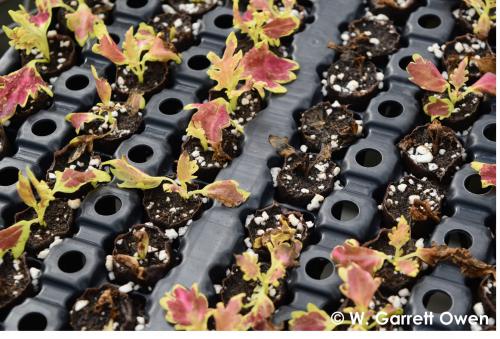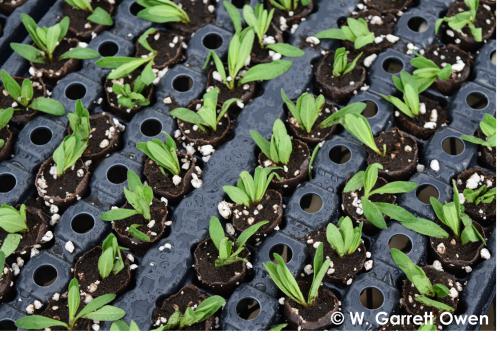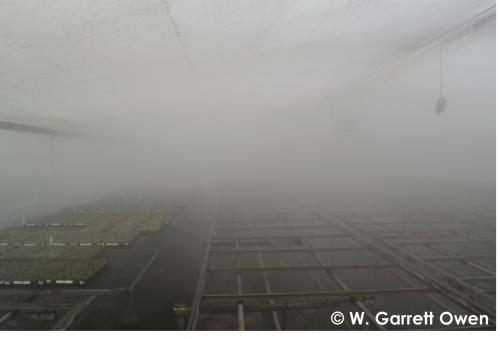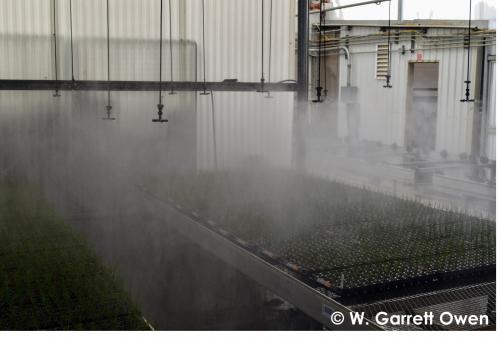Moisture management during vegetative cutting propagation
Managing and controlling moisture during cutting propagation is critical to finish high-quality, well-rooted liners.

During propagation, unrooted cuttings require water to prevent desiccation (death) and for processes such as photosynthesis, which influence root development and growth. Propagators must minimize transpiration (leaf water loss) until root formation and development occurs and cuttings have the ability to replace lost water.
From stick to root development (Stages 1-3), propagators sometimes use too little water or moisture, but most often provide too much water, which leads to leaching and waterlogged propagation substrates (Fig. 1), uneven rooting and loss of cuttings due to rot (Fig. 2) or botrytis. In order to produce high-quality rooted cuttings, propagators must manage moisture in the propagation environment along with light, temperature, and nutrition.
Figure 2. Providing too much moisture during propagation can result in rot and cutting loss.
A practice often observed during propagation of unrooted cuttings is frequent, heavy misting, which provides too much moisture and should be avoided. The purpose of misting is to provide enough moisture on the leaf to prevent wilting and desiccation. Prior to sticking of cuttings, the propagation substrate should be irrigated to the point where water drips from the liner trays or moisture level 5. The available water in the propagation substrate will supply the moisture required by the cutting to remain turgid once roots emerge.
Providing proper moisture management after cuttings are placed in the propagation environment may be challenging because of crop diversity and differing moisture requirements among species and rates of root development. Certain crops require more mist to remain turgid, especially in the first few days of propagation. Other crops need to be kept drier. Group these crops together to make life easier during propagation. Table 1 provides a list of species that have high and low mist requirements during propagation.
|
Table 1. List of species requiring high and low misting during unrooted cutting propagation. | |
|---|---|
|
HIGH mist group |
LOW mist group |
|
Angelonia |
Evolvulus |
|
Argyranthemum |
Geraniums |
|
Bracteantha |
Helichrysum |
|
Celosia |
Portulaca |
|
Osteospermum |
Sedum |
|
Scaevola |
Streptocarpella |
Optimizing moisture during propagation is a balancing act between water absorption and transpiration. Humidity in the propagation environment greatly influences the rate of water loss; as humidity in the propagation environment decreases, transpiration increases, causing cuttings wilt faster (Fig. 3).
Figure 3. Wilted cuttings are the result of increased transpiration from decreased humidity in the propagation environment.
Humidity can be difficult to control. Most often, we refer to humidity as relative humidity or the proportion of water vapor in the air equated to how much the air could hold at a given temperature. A more useful and absolute measurement of humidity is vapor pressure, which is the measure of water vapor (gaseous form) in the air, and vapor pressure deficit (VPD), which is the difference between the actual vapor pressure (moisture in the air) and saturation vapor pressure (maximum water vapor pressure or how much moisture the air can hold when saturated). Essentially, vapor pressure deficit quantifies how close the propagation air is to saturation at any given temperature. To minimize transpiration, propagators should maintain a low vapor pressure deficit (air is near saturation) around 0.3 kPa.
To provide the moisture needed to keep propagation environments humid, fogging (Fig. 4), overhead misting (Fig. 5) or boom systems can utilized. The most common of these among Michigan growers is misting systems. A typical misting frequency during sticking (Stage 1) and callusing (Stage 2) of vegetative cutting propagation is to initially mist for 5–8 seconds every 5–10 minutes over 24-hour period. After three to four days, reduce mist to 3–5 seconds every 10–20 minutes during the day, and less frequently at night. Do not limit misting during sticking because this keeps the cuttings turgid. Misting frequency should depend on the species, current weather conditions and propagation environment. Generally, misting should be more frequent when it’s sunny, and less frequent when it’s cloudy.
Figure 4. Moisture during unrooted vegetative cutting propagation can be provided by overhead fogging system.
Figure 5. Moisture during unrooted vegetative cutting propagation can be provided by an overhead misting system.
When roots become visible, misting frequency can be reduced because cuttings have now passed into the root development phase (Stage 3). At this time, cuttings can be irrigated and provided a low rate of nutrition (50 to 70 ppm nitrogen). At toning (Stage 4), very little to no mist should be applied. The relative humidity in the propagation environment during toning can be similar to a production environment to help condition rooted cuttings for transplant or endure the rigors of shipping.
Moisture management in the propagation environment is an integral cultural practice that when combined with optimal environmental conditions, will result in high-quality, well-rooted liners.



 Print
Print Email
Email







